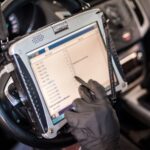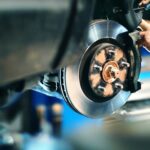
In this article, we’ll explore both DIY and professional car dent removal options, outlining the best tips and tools to help you decide which approach is right for your situation.
DIY Car Dent Removal Methods
For those who prefer tackling the problem on their own, there are several ways to remove dents that can be done using tools or household items. These methods are typically most effective on smaller dents that haven’t caused significant damage to the paint or structure of the vehicle.
The Plunger Method
It might seem strange, but a simple household plunger can be a very effective tool for minor dents. This technique works best on shallow dents that are located on flat surfaces, such as doors or hoods.
To use this method:
- Clean the dented area to ensure there’s no dirt or debris that could damage the paint.
- Wet both the plunger and the dent with water to create suction.
- Press the plunger firmly over the dent and pull quickly, repeating as necessary.
While the plunger method doesn’t guarantee success for all dents, it’s an inexpensive and easy first step.
Hot Water and Cold Air
This technique is especially useful for plastic bumpers that can get dented quite easily. The heat from boiling water softens the plastic, while the cold air causes it to contract, often pushing the dent back into place.
Here’s how to use this method:
- Pour hot (not boiling) water over the dented area.
- Immediately after, spray compressed air on the same spot to cool the plastic down quickly.
This temperature contrast can pop the dent out as the plastic returns to its original shape. While this method may not work for all dents, it’s worth trying before investing in more expensive car dent removal tools.
Hairdryer and Compressed Air
A variation of the hot and cold method, this technique uses a hairdryer and a can of compressed air to remove dents. The idea is similar – using heat to expand the metal or plastic and cold air to contract it.
Here’s how to do it:
- Heat the dent with the hairdryer for 30-60 seconds.
- Quickly spray the area with compressed air, holding the can upside down to release the cold air.
The rapid temperature change should cause the metal or plastic to contract, helping to push the dent out. Like other DIY methods, this technique works best on smaller dents and may not be as effective for larger ones. Knowing how to remove dents from car panels using heat and cold is a useful skill for minor repairs.
Professional Dent Removal Options
While DIY methods can be useful for small, superficial dents, more severe damage will require professional attention. When it comes to larger or deeper dents, or when the paint has been damaged, professional car dent removal is the safest and most effective route.
Paintless Dent Repair (PDR)
Paintless Dent Repair (PDR) is one of the most popular professional methods when you need to find out on how to remove dents from car. It involves using specialized car dent removal tools to gently push and massage the dented metal back into its original position. This technique is highly effective for dents that haven’t cracked or chipped the paint.
The process:

- A technician will assess the location and size of the dent.
- They will use tools to gain access to the backside of the panel, often through windows, wheel wells, or door openings.
- Using precise pressure, the technician will carefully work the metal back into place, preserving the original paint finish.
PDR is cost-effective and can often be completed in just a few hours. It’s ideal for minor to moderate dents that don’t affect the vehicle’s structural integrity, and it’s a professional-level solution when you need to know how to remove dents from car surfaces without damaging the paint.
Body Filler and Repainting
For more extensive damage, such as deep dents or areas where the paint has been chipped, a professional body shop may use body filler and repainting techniques.
Here’s how it works:
- The technician will sand down the dented area to prepare it for repair.
- A body filler, such as Bondo, is applied to fill in the dent.
- After the filler hardens, the surface is sanded down to a smooth finish.
- The area is then primed and painted to match the rest of the car.
While this method is more invasive and time-consuming, it’s essential for severe dents and ensures a flawless finish. Body filler and repainting are commonly used when the damage is too significant for paintless dent repair. This approach is crucial for larger dents that require more than just basic knowledge of dent removal
Dent Pullers
For larger dents, a professional may use specialized dent pullers. These car dent removal tools work by attaching to the dent and pulling it out with precision.
There are two main types of dent pullers:
- Suction Dent Pullers: Similar to the plunger method but more powerful, these tools use a strong suction cup to pull the dent out.
- Glue Dent Pullers: These involve applying glue to a pulling tab that is then attached to the dent. The tab is pulled out using a pulling tool, gradually pulling the dent back to its original form.
Dent pullers are highly effective but require skill and precision, which is why they are best left to professionals for more serious damage. If you’re researching how to remove dents from car doors or panels with deep damage, dent pullers are a viable option.
When to Choose DIY vs. Professional Help
While knowing how to remove a dent from your car can save you time and money, it’s important to recognize when professional help is necessary. Here are some factors to consider:
- Size of the Dent: Small, shallow dents can often be fixed at home using simple tools. However, large or deep dents typically require professional attention.
- Location of the Dent: Dents on flat surfaces (like doors or the hood) are easier to fix than those on curved areas or near edges, where the metal is stronger.
- Paint Damage: If the paint is chipped or cracked, DIY methods are unlikely to be effective. Professional techniques like body filler and repainting will be necessary to restore the car’s appearance.
- Experience: If you’re comfortable using DIY methods and have the right tools, you can attempt minor repairs at home. However, if you’re inexperienced, there’s a risk of causing more damage, making professional help the better option.
Choosing the Right Tools for DIY Dent Removal
For those who want to try fixing dents on their own, investing in the right car dent removal tools can make all the difference.
Here are some recommended tools:
- Suction cup dent puller: Useful for small to medium dents.
- Dent repair kit: These kits come with glue tabs, pulling tools, and other accessories to help pull out dents effectively.
- Heat gun or hairdryer: Essential for techniques that rely on heating the dented area.
- Compressed air: For cooling the surface after heating and helping the dent pop out.
Having these tools on hand can give you more control over small dents and scratches, potentially saving you a trip to the body shop and increasing your confidence in how to remove dents from car panels.
Final Thoughts
Removing dents from your car doesn’t always have to be a stressful or costly process. With the right approach, you can take care of minor dings and dents yourself using household items or specialized car dent removal tools. However, for larger or more complex damage, professional dent removal services are often the best route to ensure the job is done right.

Whether you choose a DIY solution or opt for professional help, maintaining the appearance of your car not only keeps it looking good but also helps retain its value over time. When in doubt, consult with a professional to ensure you’re taking the best course of action for your vehicle.






































